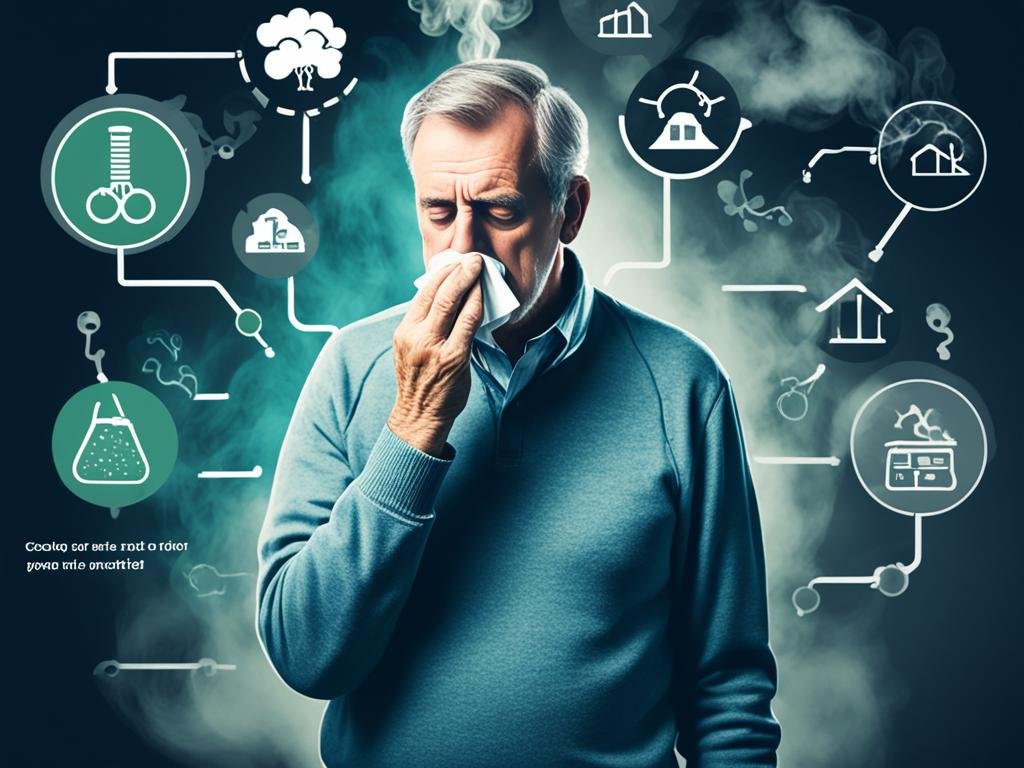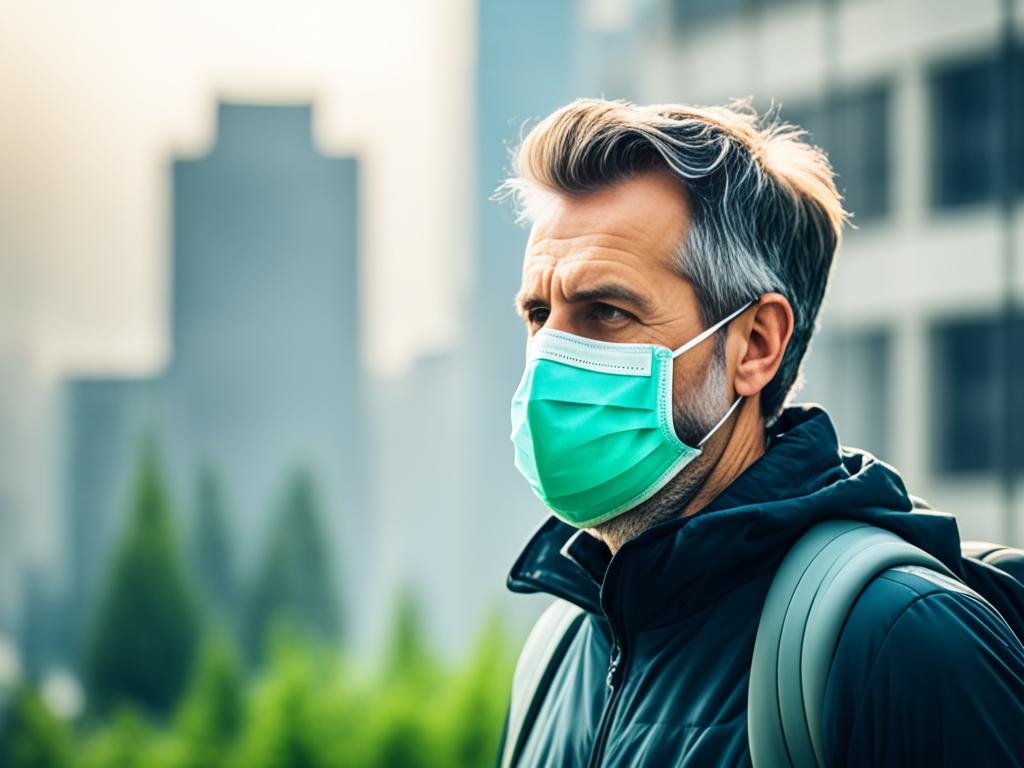Environmental Factors and COPD: Minimizing Exposure to Pollutants
March 9, 2024 | by spousingitup

Hello, Canada! We want to share our story of resilience and the transformative power of art in overcoming the daily challenges posed by our health conditions. I, as the writer, navigate life with osteoporosis, a condition characterized by weakened bones, while my husband copes with agoraphobia, severe anxiety, and depression. Together, we face unique obstacles that impact both our physical and mental well-being. However, we have discovered that creative pursuits provide therapy and solace, allowing us to express ourselves and find meaning amidst the ups and downs of our journey.
Living with COPD, a lung disease that affects my breathing, has taught me the significance of environmental factors in my respiratory health. I have learned to be mindful of the pollutants in our surroundings and the importance of minimizing my exposure to them. By understanding how environmental pollutants can worsen COPD symptoms, I have been able to take proactive measures to protect our lung health.
Key Takeaways:
- Managing osteoporosis and COPD alongside mental health conditions poses daily challenges.
- Creative pursuits such as art can provide therapy and solace in the face of health obstacles.
- Minimizing exposure to environmental pollutants is crucial in managing COPD symptoms.
- Resilience and the power of creativity play a profound role in improving mental and physical well-being.
- Our shared journey demonstrates the potential of art as a form of healing and expression.
The Impact of Air Quality on COPD
Outdoor air pollution can have detrimental effects on respiratory health, especially for individuals with COPD. Poor air quality is known to worsen COPD symptoms and accelerate lung function decline. Particulate matter (PM 2.5) and nitrogen dioxide are the key culprits responsible for these adverse effects.
Exposure to particulate matter, such as dust and soot, is a significant trigger for COPD exacerbations. PM 2.5, which consists of tiny particles suspended in the air, can penetrate deep into the lungs and aggravate respiratory symptoms. Sources of PM 2.5 include motor vehicles, factories, power plants, wood burning, and even wildfires.
Nitrogen dioxide is primarily emitted from vehicle exhaust and industrial processes. High concentrations of nitrogen dioxide can irritate the respiratory system, leading to COPD exacerbations. It is crucial for individuals with COPD to be vigilant about their local air quality and take proactive measures to minimize their exposure to these environmental pollutants.
| Common Sources of Particulate Matter (PM 2.5) | Common Sources of Nitrogen Dioxide |
|---|---|
| Motor vehicles | Vehicle exhaust |
| Factories | Industrial processes |
| Power plants | |
| Wood burning | |
| Wildfires |
Monitoring air quality and staying informed about local pollution levels can help individuals with COPD make informed decisions about outdoor activities. It is advisable to limit time spent outdoors on days when air quality is particularly poor. When venturing outside, wearing a mask that filters out particulate matter can provide additional protection.
Quotes
“Understanding the impact of air quality on COPD is essential for managing the condition effectively. Minimizing exposure to pollutants can help individuals with COPD breathe easier and reduce the risk of exacerbations.” – Dr. Emily Thompson, Pulmonologist
In addition to outdoor air pollution, it is important to address indoor air quality as well. Section 3 will delve into the contribution of indoor pollutants to COPD development and exacerbation.
Indoor Air Pollution and COPD
Indoor air pollution is a significant concern when it comes to the development and worsening of COPD. Alongside outdoor air pollution, it poses a threat to respiratory health and exacerbation of COPD symptoms. It is essential to understand the sources of indoor air pollution and take steps to minimize exposure to these environmental irritants.
Secondhand Smoke: Exposure to secondhand smoke, especially during childhood, has been linked to an increased risk of developing COPD later in life. Secondhand smoke contains harmful chemicals and particulate matter that can irritate the respiratory system, aggravate COPD symptoms, and contribute to disease progression.
Coal Burning and Wood Burning Stoves: Burning fossil fuels like coal and using wood-burning stoves can release harmful pollutants into the air, including particulate matter and chemicals. These pollutants can irritate the lungs and worsen COPD symptoms. Minimizing exposure to coal smoke and wood smoke is crucial to maintain respiratory health for individuals with COPD.
Proper ventilation plays a significant role in reducing indoor air pollution. Opening windows, using exhaust fans, and maintaining clean air filters can help remove pollutants from the indoor environment and improve air quality. Additionally, avoiding smoking and exposure to secondhand smoke is vital for individuals with COPD.

Quotes:
“The exposure to indoor air pollution, such as secondhand smoke and burning of coal or wood, can have detrimental effects on individuals with COPD. Minimizing exposure to these environmental irritants is crucial for the management and prevention of COPD.” – Dr. Jane Collins, Pulmonologist
Indoor Air Pollutants and Their Effects on COPD
| Pollutant | Effect on COPD |
|---|---|
| Secondhand Smoke | Increases the risk of COPD development and exacerbates symptoms |
| Coal Smoke | Worsens COPD symptoms and contributes to disease progression |
| Wood Smoke | Irritates the respiratory system and aggravates COPD symptoms |
Occupational Exposures and COPD
Occupational exposures to harmful chemicals, dust, and fumes can significantly increase the risk of developing chronic obstructive pulmonary disease (COPD). Research has shown that these workplace exposures contribute to a significant percentage of respiratory symptoms and lung function impairment associated with COPD. Certain occupations, such as construction, mining, agriculture, and manufacturing, have been particularly linked to higher rates of COPD.
To safeguard the respiratory health of workers, it is crucial for employers and employees to prioritize workplace safety. This includes providing appropriate protective equipment and ensuring proper training on how to minimize exposure to occupational hazards. By implementing preventive measures, such as implementing effective ventilation systems and using respiratory protective equipment, employers can mitigate the risks associated with occupational exposures.
The Importance of Workplace Safety
Workplace safety plays a vital role in protecting employees from occupational exposures that can contribute to the development or exacerbation of COPD. By creating a safe working environment, employers can not only prevent COPD but also improve overall employee well-being. Here are key aspects of workplace safety in relation to COPD:
- Providing adequate protective equipment: Employers should ensure that employees have access to high-quality respiratory protective equipment, such as masks or respirators, that effectively filter out harmful particles and gases.
- Maintaining proper ventilation: Adequate ventilation plays a crucial role in reducing the concentration of pollutants in the workplace. Employers should regularly inspect and maintain ventilation systems to ensure optimal performance.
- Implementing exposure control measures: Implementing engineering controls and administrative measures can minimize exposure to hazardous substances. For example, employers can use enclosed processes or substituting harmful chemicals with safer alternatives.
- Training and education: Employers should provide comprehensive training on workplace safety, including the proper use of protective equipment and safe handling of hazardous materials. Education and awareness programs can help employees understand the importance of minimizing occupational exposures and taking preventive measures.
By prioritizing workplace safety and taking proactive measures to minimize occupational exposures, employers can promote the well-being of their workforce and contribute to the prevention of COPD. A collaborative effort between employers, employees, and regulatory bodies is essential to ensure a safe and healthy working environment.
“Workplace safety is not just about complying with regulations; it is about protecting the health and well-being of employees. By minimizing occupational exposures, we can create safer working environments and reduce the risk of respiratory diseases like COPD.”
Occupational Exposures and COPD Statistics
Let’s take a closer look at the impact of occupational exposures on COPD rates:
| Occupation | Percentage of Workers with COPD |
|---|---|
| Construction Workers | 25% |
| Miners | 18% |
| Agricultural Workers | 14% |
| Manufacturing Workers | 12% |
These statistics highlight the significant impact of occupational exposures on COPD prevalence. It underscores the importance of implementing effective preventive measures and ensuring workplace safety to protect the respiratory health of workers.
Managing COPD and Minimizing Environmental Exposures
Effective management of COPD involves not only addressing symptoms but also minimizing exposure to environmental irritants that can worsen the condition. By taking proactive steps to reduce these environmental factors, individuals with COPD can improve their lung health and overall well-being.
Quit Smoking: Reduce the Risk
Quitting smoking is a critical step in reducing the risk of COPD progression and exacerbations. Smoking damages the lungs and contributes to the development of COPD. It is essential for individuals with COPD to quit smoking and avoid exposure to secondhand smoke.
Awareness of Environmental Surroundings
Being aware of your environmental surroundings can help minimize exposure to irritants that worsen COPD. Pay attention to air quality and avoid spending time in areas with high levels of pollution. Regularly check the Air Quality Index (AQI) in your area to plan outdoor activities accordingly. Stay updated on weather conditions, especially during wildfire seasons, to reduce exposure to smoke and other irritants.
Indoor Air Quality: Create a Clean Environment
Ensure good indoor air quality to minimize exposure to environmental irritants. Avoid using products that release chemicals or produce strong odors, such as cleaning agents, pesticides, and air fresheners. Keep your home well-ventilated by opening windows or using air purifiers. Regularly clean and maintain heating systems, air conditioners, and filters to prevent the buildup of allergens and pollutants.
Reducing Occupational Hazards
Reducing exposure to occupational hazards is crucial in minimizing the risk of COPD. If your job involves exposure to chemicals, dust, or fumes, ensure that you have proper protective equipment and follow safety protocols. Talk to your employer about implementing measures to reduce occupational exposures, such as ventilation systems and training programs.
Access to Healthcare: Support and Prevention
Access to healthcare is vital for managing COPD and preventing complications. Regular check-ups, vaccinations, and consultations with healthcare professionals can help monitor your lung health and provide guidance on managing your condition. Work with your healthcare team to develop an individualized COPD management plan that includes strategies to minimize environmental exposures.

| Managing COPD and Minimizing Environmental Exposures | Benefits |
|---|---|
| Quit smoking | Reduces the risk of COPD progression and exacerbations |
| Awareness of environmental surroundings | Minimizes exposure to high levels of pollution and irritants |
| Improve indoor air quality | Reduces exposure to harmful chemicals and allergens |
| Reduce occupational hazards | Minimizes exposure to workplace irritants and pollutants |
| Access to healthcare | Provides support, monitoring, and preventive care |
Conclusion
Environmental factors play a significant role in the development and progression of COPD. It is essential to understand that while smoking is the leading cause of COPD, exposure to environmental pollutants, both indoors and outdoors, can also contribute to this chronic lung disease. To prevent COPD and manage symptoms for those already diagnosed, we must prioritize minimizing exposure to these pollutants and promoting respiratory health.
By taking steps to reduce risk factors and maintain good respiratory health, individuals can protect their lungs and improve their quality of life. This includes avoiding smoking and secondhand smoke, ensuring good indoor air quality, and reducing exposure to occupational hazards. It is also crucial to have access to healthcare, regular check-ups, and vaccinations, which are key in managing COPD and preventing complications.
In reducing the burden of COPD on individuals and society as a whole, we must prioritize prevention and create awareness about environmental factors. Through education and action, we can minimize COPD risk factors, promote respiratory health, and ensure a healthier future for all.
FAQ
What causes COPD?
The main cause of COPD is smoking, which accounts for approximately 75% of cases. However, exposure to environmental pollutants such as chemicals, dust, and fumes in occupational settings can also contribute to the development and exacerbation of COPD.
How does air quality affect COPD?
Poor air quality, particularly the presence of particulate matter (PM 2.5) and nitrogen dioxide, can worsen COPD symptoms and accelerate the decline in lung function. Exposure to outdoor air pollution from sources like motor vehicles, factories, and wildfires can trigger exacerbations of COPD.
How does indoor air pollution impact COPD?
Indoor air pollution, such as secondhand smoke, coal burning, and wood burning stoves, can release harmful particulate matter and chemicals that irritate the respiratory system and worsen COPD symptoms. Minimizing exposure to these indoor pollutants is crucial for maintaining respiratory health.
What are occupational exposures and how do they relate to COPD?
Occupational exposures refer to the harmful chemicals, dust, and fumes that individuals may encounter in certain job settings. These exposures can increase the risk of developing COPD and contribute to respiratory symptoms and lung function impairment consistent with the disease.
How can COPD be managed and environmental exposures minimized?
Quitting smoking is a critical step in managing COPD and reducing the risk of exacerbations. It’s also important to maintain good indoor air quality, avoid smoking or exposure to secondhand smoke, and reduce exposure to occupational hazards. Access to healthcare, including regular check-ups and vaccinations, is essential in managing COPD and preventing complications.
How can I prevent COPD and protect my respiratory health?
Preventing COPD involves reducing risk factors such as smoking and minimizing exposure to environmental irritants. By being aware of your surroundings, practicing good respiratory hygiene, and seeking medical care when needed, you can protect your lungs and improve your quality of life.
Source Links
RELATED POSTS
View all



